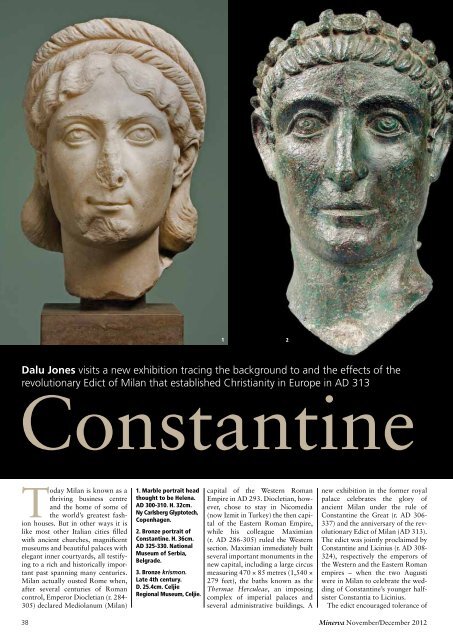Following Odysseus Not the end of the world Amarna city of light ...
Following Odysseus Not the end of the world Amarna city of light ...
Following Odysseus Not the end of the world Amarna city of light ...
- No tags were found...
You also want an ePaper? Increase the reach of your titles
YUMPU automatically turns print PDFs into web optimized ePapers that Google loves.
Exhibition1 2Dalu Jones visits a new exhibition tracing <strong>the</strong> background to and <strong>the</strong> effects <strong>of</strong> <strong>the</strong>revolutionary Edict <strong>of</strong> Milan that established Christianity in Europe in AD 313ConstantineToday Milan is known as athriving business centreand <strong>the</strong> home <strong>of</strong> some <strong>of</strong><strong>the</strong> <strong>world</strong>’s greatest fashionhouses. But in o<strong>the</strong>r ways it islike most o<strong>the</strong>r Italian cities filledwith ancient churches, magnificentmuseums and beautiful palaces wi<strong>the</strong>legant inner courtyards, all testifyingto a rich and historically importantpast spanning many centuries.Milan actually ousted Rome when,after several centuries <strong>of</strong> Romancontrol, Emperor Diocletian (r. 284-305) declared Mediolanum (Milan)1. Marble portrait headthought to be Helena.AD 300-310. H. 32cm.Ny Carlsberg Glyptotech,Copenhagen.2. Bronze portrait <strong>of</strong>Constantine. H. 36cm.AD 325-330. NationalMuseum <strong>of</strong> Serbia,Belgrade.3. Bronze krismon.Late 4th century.D. 25.4cm. CeljieRegional Museum, Celjie.capital <strong>of</strong> <strong>the</strong> Western RomanEmpire in AD 293. Diocletian, however,chose to stay in Nicomedia(now Izmit in Turkey) <strong>the</strong> <strong>the</strong>n capital<strong>of</strong> <strong>the</strong> Eastern Roman Empire,while his colleague Maximian(r. AD 286-305) ruled <strong>the</strong> Westernsection. Maximian immediately builtseveral important monuments in <strong>the</strong>new capital, including a large circusmeasuring 470 × 85 metres (1,540 ×279 feet), <strong>the</strong> baths known as <strong>the</strong>Thermae Herculeae, an imposingcomplex <strong>of</strong> imperial palaces andseveral administrative buildings. Anew exhibition in <strong>the</strong> former royalpalace celebrates <strong>the</strong> glory <strong>of</strong>ancient Milan under <strong>the</strong> rule <strong>of</strong>Constantine <strong>the</strong> Great (r. AD 306-337) and <strong>the</strong> anniversary <strong>of</strong> <strong>the</strong> revolutionaryEdict <strong>of</strong> Milan (AD 313).The edict was jointly proclaimed byConstantine and Licinius (r. AD 308-324), respectively <strong>the</strong> emperors <strong>of</strong><strong>the</strong> Western and <strong>the</strong> Eastern Romanempires – when <strong>the</strong> two Augustiwere in Milan to celebrate <strong>the</strong> wedding<strong>of</strong> Constantine’s younger halfsisterConstantia to Licinius.The edict encouraged tolerance <strong>of</strong>38Minerva November/December 2012
















